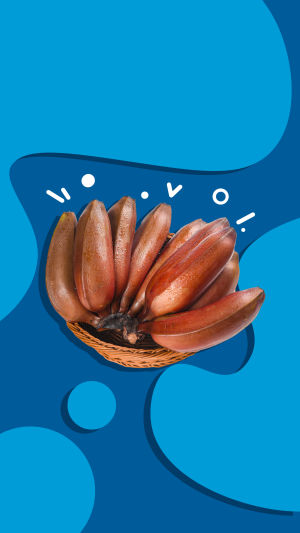The red banana is a kind of banana. Its skin is dark purplish red and tastes sweet.
Red bananas are native to Southeast Asia. The pseudostem is 3 ~ 4 m high and 67 ~ 87 cm in circumference. In addition to the green leaf surface, the pseudostem, vein, and midvein are dark purplish red. It has a special scent and smells like orchids. The total sugar content of fruit is 20%-21%.
The yield of red bananas is low, each plant produces 10 ~ 20 kg. The variety is prone to mutate into a green banana. Long growth period, more than 15 months, disease resistance, cold resistance is weak.
So what's the difference between a red-skinned banana and a normal banana?
1. Color is different. The skin of a banana is red when it is not ripe. When it is ripe, it turns deep red. Yellow bananas are green when they are not ripe and yellow when they are ripe.
Inside the flesh color is not very different, is mainly yellow. But the price difference between the two is relatively large.
2. Taste is different. The inside of a red-skinned banana has the same color as the inside of a yellow-skinned banana, but it tastes a little different. The flesh of a red-skinned banana is sweeter than that of a yellow-skinned banana.
3. Storage time is different. We all know that yellow-skinned bananas, which are bought in the wet market, tend to turn black after a day or two of ripening. But red-skinned bananas will last longer than yellow-skinned ones.
Eating bananas has the function and effect of supplementing nutrition, promoting appetite, and preventing constipation. However, it is necessary to avoid eating too much at one time, so as not to increase the burden on the gastrointestinal tract and cause indigestion.
1. Get some nutrition. Red banana contains fructose, pectin, organic acid, dietary fiber, and other nutrients, as well as vitamin C, folic acid, and other vitamins, but also contains calcium, phosphorus, iron, zinc, copper, magnesium, and other mineral components.
Eating the right amount of red bananas can play the role of supplementing the human body's needs for nutrients.
2. Increase your appetite. Red bananas contain a lot of organic acids, which can promote the secretion of digestive enzymes. It has the function and effect of increasing appetite, but also can promote the digestion and absorption of food.
3. Prevent constipation. Red banana contains a lot of dietary fiber, which can stimulate gastrointestinal peristalsis. Promote the excretion of gastrointestinal contents, which can play a certain auxiliary role in preventing constipation.
4. Curb elevated blood pressure.
So when is a banana better to eat?
You can choose to eat it in the morning or the afternoon when you are hungry. At this time bananas can be used as a supplement for calories and nutrients. Bananas are usually eaten at 10 am, 3 PM, or one hour before going to bed at night.
Mid-morning bananas are best. After a long meal of work and study, the body is depleted of carbohydrates. Eat bananas. The fructose and glucose in bananas are quickly absorbed by the body.
To fuel your brain and body, which is when your body is more active. Bananas are rich in vitamins and minerals that can promote the body's metabolism.
But it's not recommended that you eat a banana right after a meal. Avoid consuming too many calories, which can lead to higher blood sugar after meals and increase the burden on the pancreas.





